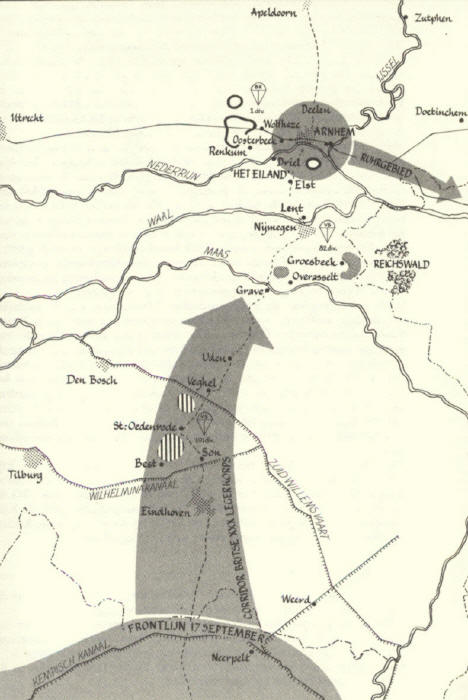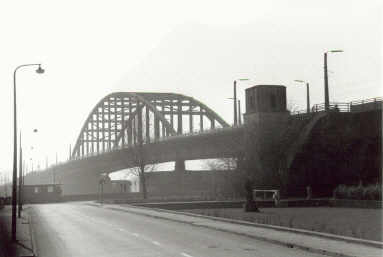voor meer: www.tiemens.info
THE BATTLE OF ARNHEM
17-26 September 1944
Arnhem: a medium-sized city in the heart of the Netherlands. The capital of Gelderland, the largest province, Arnhem is famous for its many parks and places of interest, same of which, such as the Burgers' Zoo, the Dutch Open-Air Museum and the Hoge Veluwe National Park with its Kröller-Müller Museum, are of international renown. But what made this provincial capitaI on the Rhine into an international household name was, above all, the dramatic conflict that took place there in September 1944: the BattIe of Arnhem. With the German troops in France retreating in disarray before his divisions and no longer offering any significant resistance, Field Marshal Montgomery thought there might be a chance of forcing Nazi Germany to surrender before the onset of winter. Working under extreme pressure, his staff produced a number of plans for a final offensive. Plans which were rapidly overtaken by the stormy developments of the following days, before there could be any thought of carrying them out. The Allies' advance ground to a halt in the north of Belgium on about 4 September 1944 because of difficulties with the supply of fuel. Precious time was lost. On 8 September, the Germans launched their first V2 rocket on London from the west of the Netherlands. Under these circumstances, Monty's plans for a bold attack took shape more and more clearly. The 30th Army Corps was to advance north from its bridgehead near Neerpelt in Belgium into the Netherlands along a line stretching from Eindhoven through Nijmegen and on to Arnhem. The main army would then turn eastwards and invade Germany.

The plan for Operation Market Garden
In this way, it would avoid the Siegfried Line, a strong line of defence along part of the Reich's western frontier. A smaller army would advance as far as the Zuiderzee, thereby cutting off the west of the Netherlands with the V2 launch sites. However, there was the danger that the Germans would destroy the various bridges in the path of Montgomery's troops before the rapidly advancing infantry could reach them. In order to prevent the Germans from carrying out such plans, airborne forces were to take and secure the bridges in a surprise attack. This combined attack by ground and airborne farces was codenamed Operation Market Garden. As part of this offensive, on Sunday afternoon of 17 September, part of the 1st British Airborne Division under Major General Urquhart was flown in to landing areas west of Arnhem. Thousands of parachutists were dropped and hundreds of gliders carrying vehicles and artillery landed in fields near Wolfheze, ten kilometres from their main objective, the bridge over the Lower Rhine at Arnhem. In the days that followed, the rest of the division was flown in and part of the 1st Polish Independent Parachute Brigade was dropped south of the Rhine near Driel. But the Polish troops under Major General Sosabowski could only watch helplessly from their positions as their British comrades across the river were forced into an increasingly dangerous position. Though the landings themselves had been a great success, the subsequent march on Arnhem did not go according to plan. Due to the presence in the immediate vicinity of the Arnhem landing and dropping zones of an extremely important Luftwaffe command centre, the Germans could react with unexpected speed and force. Only one battalion reached its objective in the evening of that same day. This was the 2nd Battalion under Lieutenant Colonel Frost, which, in fact, only succeeded in taking the northern approach to the bridge. The southern approach remained firmly in German hands. In the following days the Germans succeeded in preventing the rest of the allied forces from joining Frost' s troops, who were still managing to hold their positions. Only a few small groups were able to reach Frost. In this perilous situation, he and his men held out much longer than had been planned. They waited in vain, however, for the arrival of the 30th Army Corps, whose advance was much slower than expected. During the night of 20 September, Frost was obliged to retreat in the face of the Germans' crushing superiority. The bridge was, once again, entirely in German hands. The rest of the division was pushed back, during heavy fighting, into an ever decreasing area around Oosterbeek, a village a few kilometres west of Arnhem. Major General Urquhart managed for a few days to keep a bridgehead near the north bank of the Lower Rhine. But when it became clear that the main force of the Army Corps would never reach it, he was ordered to pull back across the river, with the remnants of what, only a few days before, had been a proud division.

The road bridge over the Lower Rhine: for Operation Market Garden it proved to be a bridge too far. Since 17 December 1977 it is officially known as John Frost Bridge
This retreat, codenamed Operation Berlin, took place on the night of 26 September 1944. Of the more than 10,000 troops of 1st Airborne Division which had been deployed, only about 2,500 came back. The others were either killed in action or were rounded up, many of them wounded, and became prisoners of war. The Arnhem part of Operation Market Garden was a total failure, and went into the history books as the Battle of Arnhem. The 30th Army Corps' push forward finally ground to a halt at Elst, a small village seven kilometres south of Arnhem. And the liberation which the Corps brought in its wake also stopped there. The area between Nijmegen and Arnhem became a no man's land; the Germans flooded it in December 1944 by breaking a dike on the Lower Rhine. Arnhem became a front-line city. The population of this badly battered city and that of equally afflicted Oosterbeek was forced to evacuate. The long cold winter which followed brought much suffering to this occupied part of the Netherlands. Fuel became almost completely unavailable and the resulting lack of transport capacity contributed to the total breakdown of food distribution. This winter of starvation claimed many victims, especially in the densely populated west of the Netherlands. It goes without saying that the brave but hopeless fight put up by the British and Polish soldiers left an ineradicable impression on the Iocals, who watched these bringers of hope being defeated in the space of a few days. Immediately after the liberation, the building of a military cemetery was begun in Oosterbeek. The Renkum council provided the land. The first service of Commemoration for those who fell was held there as early as September 1945. It was to be the beginning of an unique tradition: a commemoration stretching over several days, where the population of Arnhem and the surrounding areas, veterans and relatives of those who died, come together each year to honour the Allied soldiers who fell at the Battle of Arnhem. It also goes without saying, that the many veterans present are welcomed and hospitably entertained during their stay by just as many families in the region. Strong ties of friendship have grown between them over the years. Here, as in all the other areas involved in Operation Market Garden, the Battle of Arnhem was commemorated on a large scale in September 1994 and will be on a smaller scale in 2004. But the Arnhem commemoration is different from, say, that of Eindhoven or Nijmegen, cities which, at the time, were able to welcome their liberators. There the emphasis was upon celebration, while in Arnhem it remained upon commemoration. And not only during those days in September, but all year round, as is apparent from the steady flow of visitors to the Airborne Cemetery and Airborne Museum in Oosterbeek and a number of other places where memories of the Battle of Arnhem are still strong.
 The yearly commemoration at Airborne Plein (Airborne Square), the north end of the John Frost Bridge
The yearly commemoration at Airborne Plein (Airborne Square), the north end of the John Frost Bridge